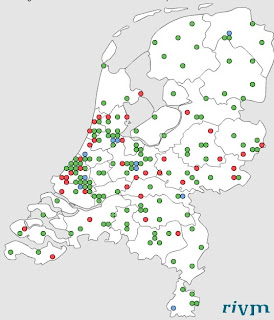 In the past few weeks the Dutch hospitals were in the news several times. The hospitals in the Flevopolder (IJsselmeer hospitals) went broke and have now been taken over by an investment company. In Zeeland negotiations to merge two hospitals were stopped. In Limburg one of the 3 hospitals in that area nearly went broke because of financial mismanagement, now over 600 nurses may lose their job. Seems that healthcare itself should go for a check up. When looking at the number and geographic spread of hospitals in the Netherlands, I wondered if we don’t have too many of them. Researching some statistics, this hunch seems to be right. Over 70% of the Dutch population can reach a hospital within 20 minutes, which is 22% above the EU average. Also the average distance to a hospital in the Netherlands is only 7 kilometres. We can do with fewer hospitals and still be well within the safety limits.
In the past few weeks the Dutch hospitals were in the news several times. The hospitals in the Flevopolder (IJsselmeer hospitals) went broke and have now been taken over by an investment company. In Zeeland negotiations to merge two hospitals were stopped. In Limburg one of the 3 hospitals in that area nearly went broke because of financial mismanagement, now over 600 nurses may lose their job. Seems that healthcare itself should go for a check up. When looking at the number and geographic spread of hospitals in the Netherlands, I wondered if we don’t have too many of them. Researching some statistics, this hunch seems to be right. Over 70% of the Dutch population can reach a hospital within 20 minutes, which is 22% above the EU average. Also the average distance to a hospital in the Netherlands is only 7 kilometres. We can do with fewer hospitals and still be well within the safety limits.
People in the US are less fortunate with respect to healthcare. 20% of the US population lives in areas with only 9% of the doctors. Moreover the cost of healthcare is 2.5 times the cost of OECD countries and continues to rise. So people in the US get less care at a higher price. More than 50 million people of the US lack insurance and as a consequence do not receive treatment when required; even Medicaid patients sometimes are not accepted. Access to healthcare can be an issue when you live in the US. Michel Moore can tell you all about it.
How to address such a challenge then? The Dutch and US situation with respect to access to hospital care is comparable to a location decision similar to the decision on where to place antennas to set up a UMTS network. The hospitals need to be located in such a way that the longest travel time of a patient is within the safety access time. The safety access time is different for emergency care than for example paediatric care, so different care types require different service times. Besides access time also the demographic characteristics of the population should be taken into account. The demographic characteristics determine the kind and demand for healthcare, elderly people usually demand more and specialised care. To give you a flavour, 80% of the cost of your life time healthcare is generated in the last 5 years of your life. Most of it is hospital care. More demand for healthcare means more doctors and beds and therefore a larger location. As such, the hospital location decision looks very much like the facility location problem, a problem that we know how to solve.
Decisions on location, size and kinds of healthcare offered are political decisions. With the use of techniques from the area Operations Research better and more objective decisions can be made on number, size and location. This will lower the cost for healthcare or enabling more care for the same Euro/Dollar. That is not the only subject were Operations Research has added value in healthcare, to name a few:
- Improve on the allocation of drugs
- Improve on the efficiency of the distribution of vaccines, redesign of vaccine programmes
- Improve blood supply chain
- Reduce organ transplants that go to waste.
- Improved budget allocation, use the available money better
- Better allocation of medical personnel; geographic spread, better schedules, improve productivity.
- Improvement on the screening programmes; early disease detection like certain cancers.
I all of these areas good work has been done, but to my opinion not known to the decision makers in healthcare. I would to invite them to read about it and to challenge us, the Operations Research practitioners, to come up with a challenge that we can not help to solve.
No comments:
Post a Comment